Portfolio: Impact of Team Dynamics and Gibbs Reflective Model Analysis
VerifiedAdded on 2023/06/18
|9
|2646
|271
Portfolio
AI Summary
This portfolio critically evaluates the impact of team dynamics on the effectiveness of project teams, emphasizing the crucial role of leadership and management. It analyzes how project teams can be managed through effective leadership and management skills to achieve team goals. The portfolio also includes a reflection on workshops attended on organizational structure and culture for high performance, utilizing Gibbs' Reflective Cycle. Key elements of team dynamics such as communication, motivation, efficiency, and innovation are discussed, along with Tuckman's theory of group development. The reflection section details experiences at Unilever, focusing on the application of organizational culture, role allocation, and communication strategies to enhance team performance and achieve project targets. The portfolio concludes with personal reflections on leadership skills and areas for future development, highlighting the importance of organizational structure in fostering individual and team growth. Desklib provides past papers and solved assignments for students.
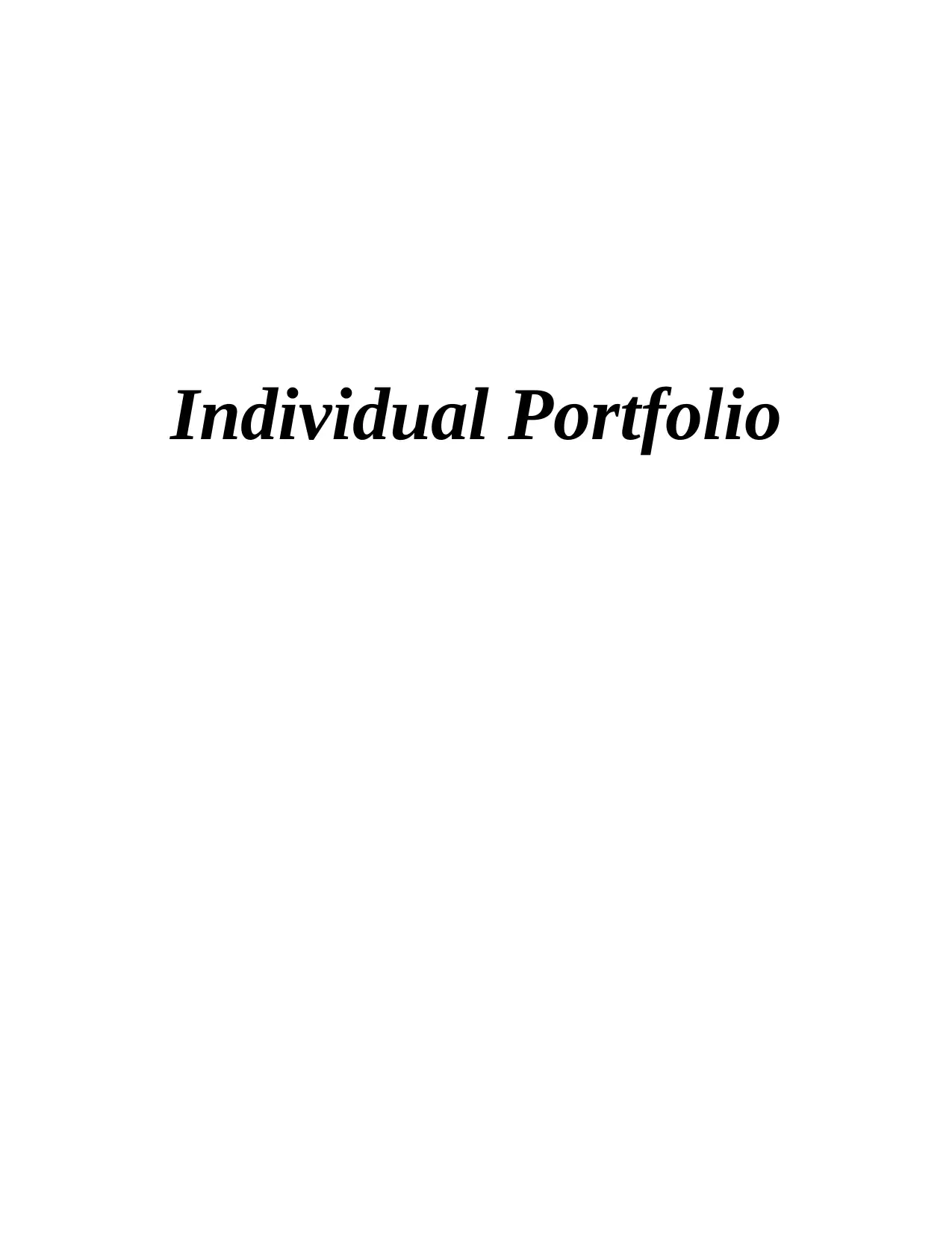
Individual Portfolio
Paraphrase This Document
Need a fresh take? Get an instant paraphrase of this document with our AI Paraphraser
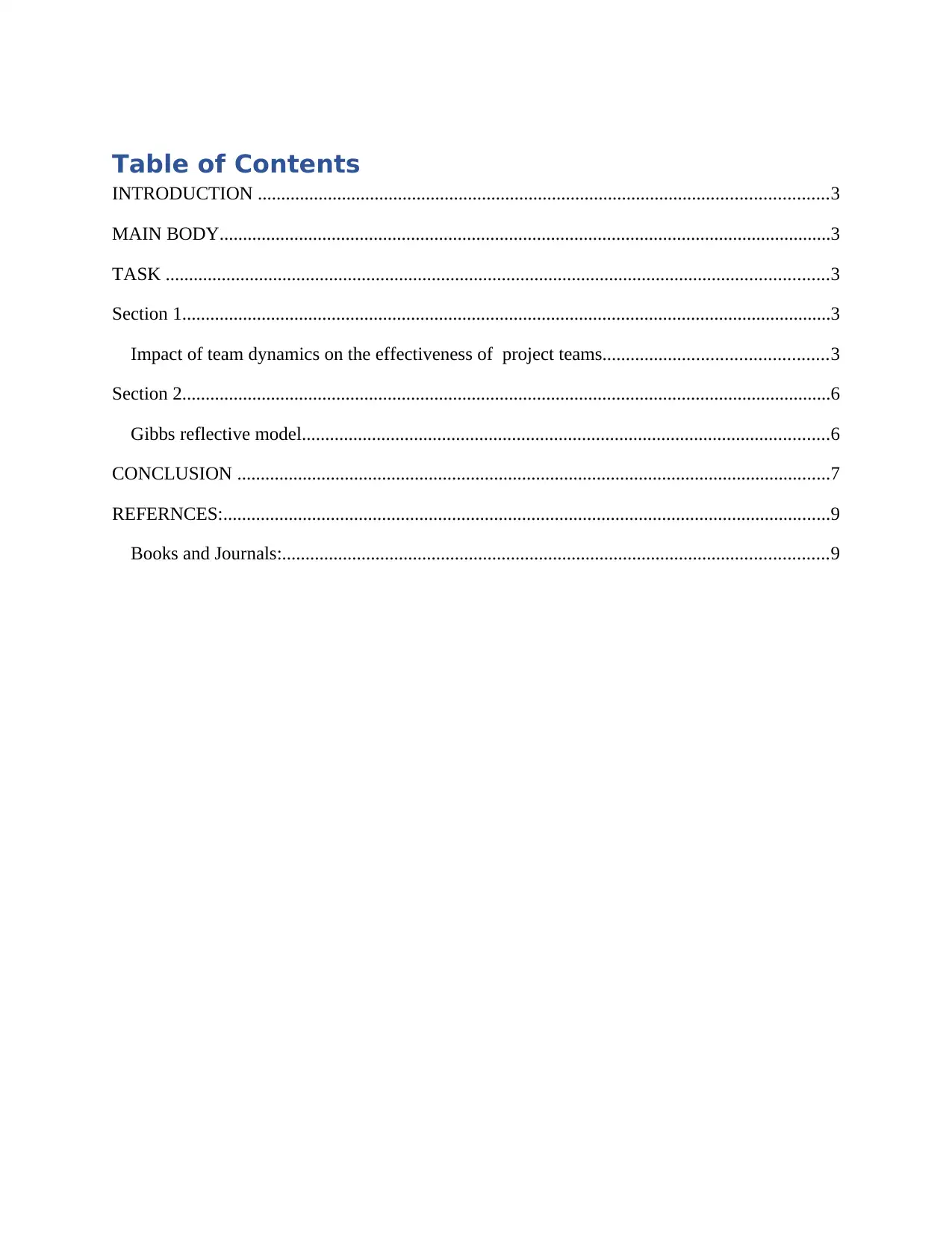
Table of Contents
INTRODUCTION ..........................................................................................................................3
MAIN BODY...................................................................................................................................3
TASK ..............................................................................................................................................3
Section 1...........................................................................................................................................3
Impact of team dynamics on the effectiveness of project teams................................................3
Section 2...........................................................................................................................................6
Gibbs reflective model.................................................................................................................6
CONCLUSION ...............................................................................................................................7
REFERNCES:..................................................................................................................................9
Books and Journals:.....................................................................................................................9
INTRODUCTION ..........................................................................................................................3
MAIN BODY...................................................................................................................................3
TASK ..............................................................................................................................................3
Section 1...........................................................................................................................................3
Impact of team dynamics on the effectiveness of project teams................................................3
Section 2...........................................................................................................................................6
Gibbs reflective model.................................................................................................................6
CONCLUSION ...............................................................................................................................7
REFERNCES:..................................................................................................................................9
Books and Journals:.....................................................................................................................9
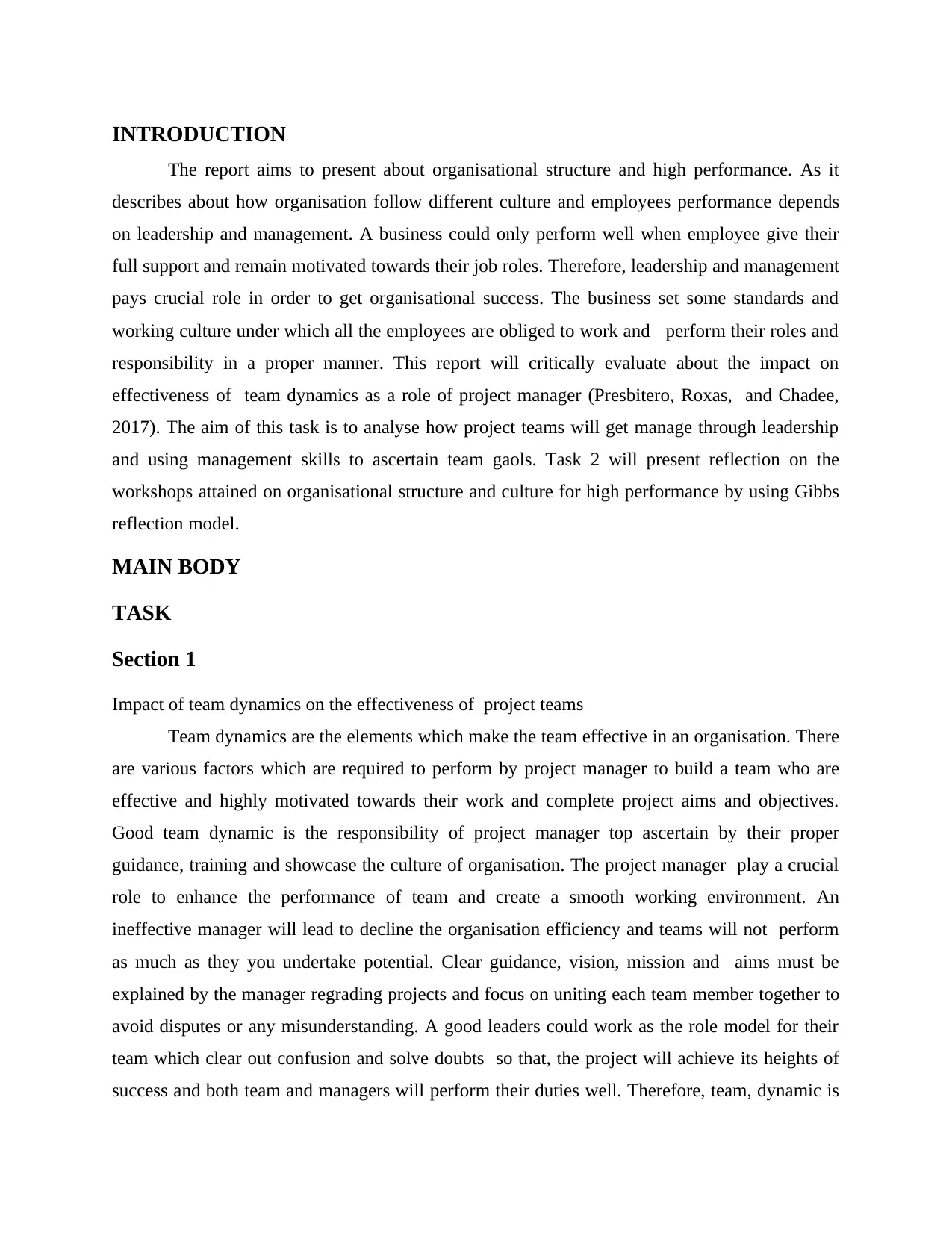
INTRODUCTION
The report aims to present about organisational structure and high performance. As it
describes about how organisation follow different culture and employees performance depends
on leadership and management. A business could only perform well when employee give their
full support and remain motivated towards their job roles. Therefore, leadership and management
pays crucial role in order to get organisational success. The business set some standards and
working culture under which all the employees are obliged to work and perform their roles and
responsibility in a proper manner. This report will critically evaluate about the impact on
effectiveness of team dynamics as a role of project manager (Presbitero, Roxas, and Chadee,
2017). The aim of this task is to analyse how project teams will get manage through leadership
and using management skills to ascertain team gaols. Task 2 will present reflection on the
workshops attained on organisational structure and culture for high performance by using Gibbs
reflection model.
MAIN BODY
TASK
Section 1
Impact of team dynamics on the effectiveness of project teams
Team dynamics are the elements which make the team effective in an organisation. There
are various factors which are required to perform by project manager to build a team who are
effective and highly motivated towards their work and complete project aims and objectives.
Good team dynamic is the responsibility of project manager top ascertain by their proper
guidance, training and showcase the culture of organisation. The project manager play a crucial
role to enhance the performance of team and create a smooth working environment. An
ineffective manager will lead to decline the organisation efficiency and teams will not perform
as much as they you undertake potential. Clear guidance, vision, mission and aims must be
explained by the manager regrading projects and focus on uniting each team member together to
avoid disputes or any misunderstanding. A good leaders could work as the role model for their
team which clear out confusion and solve doubts so that, the project will achieve its heights of
success and both team and managers will perform their duties well. Therefore, team, dynamic is
The report aims to present about organisational structure and high performance. As it
describes about how organisation follow different culture and employees performance depends
on leadership and management. A business could only perform well when employee give their
full support and remain motivated towards their job roles. Therefore, leadership and management
pays crucial role in order to get organisational success. The business set some standards and
working culture under which all the employees are obliged to work and perform their roles and
responsibility in a proper manner. This report will critically evaluate about the impact on
effectiveness of team dynamics as a role of project manager (Presbitero, Roxas, and Chadee,
2017). The aim of this task is to analyse how project teams will get manage through leadership
and using management skills to ascertain team gaols. Task 2 will present reflection on the
workshops attained on organisational structure and culture for high performance by using Gibbs
reflection model.
MAIN BODY
TASK
Section 1
Impact of team dynamics on the effectiveness of project teams
Team dynamics are the elements which make the team effective in an organisation. There
are various factors which are required to perform by project manager to build a team who are
effective and highly motivated towards their work and complete project aims and objectives.
Good team dynamic is the responsibility of project manager top ascertain by their proper
guidance, training and showcase the culture of organisation. The project manager play a crucial
role to enhance the performance of team and create a smooth working environment. An
ineffective manager will lead to decline the organisation efficiency and teams will not perform
as much as they you undertake potential. Clear guidance, vision, mission and aims must be
explained by the manager regrading projects and focus on uniting each team member together to
avoid disputes or any misunderstanding. A good leaders could work as the role model for their
team which clear out confusion and solve doubts so that, the project will achieve its heights of
success and both team and managers will perform their duties well. Therefore, team, dynamic is
⊘ This is a preview!⊘
Do you want full access?
Subscribe today to unlock all pages.

Trusted by 1+ million students worldwide

an essential part for an organisation to move with together efforts and give opportunities to boost
knowledge, skills and experience of working. For example, Unilever is one of the reputed
organisation which has scattered in many parts of world including Nigeria. The company recruit
professional individuals who could manager the diversified operation as the company has
divisional department due to having various kinds of products and services. The project
managers would not let themselves feel demotivated and keeps their team on the track of
dedication.
According to Larson, and DeChurch, 2020, it shows that company have performed well
in recent years and has achieved aims for providing healthy and organic products due to Covid-
19. There are some elements of team dynamics which needs to be ascertained by a project
manager in order to get success. These are discussed below:
Communication:It is the vital element for team dynamics. A manager needs to
communicate with their team without involving any barriers or interference. The team will only
work effectively when they are out of doubts and clarification of concepts regrading work. A
healthy communication is the key for project success. Bisbey, and Salas, 2019 believes that, It
is essential that the teams needs to perform well in order to achieve targets so that, manager
needs to communicate with each member to identify their problems, issues or consequences
faced during working. This helps in improving team effectiveness and lead to high performance
growth within team. Communication must be flexible and transparent so that, teams will
discuss about their thought, ideas which could result in some unique and innovative aspect.
Other
Motivation: The team working and their effectiveness is depend upon motivation. It
crates impact on team efficiency and potential to work. When employees get proper motivation
in terms of respect, appreciation or incentives. They become motivated to achieve the targets.
Therefore team dynamics have great impact of motivation as it binds team together which
enhance group coordination and results in project success. Unmotivated employees will create
impact on whole organisation and regulates criticism or unwanted disputes. For example, giving
bonus, incentive on completion of project as per deadline will boost potential of individuals and
keeps them, stick to their goals.
Efficiency: Team dynamic creates high impact on employee’s efficiency. A good team
will lead to give grater efficiency whereas; a demotivated and confused team will not be able to
knowledge, skills and experience of working. For example, Unilever is one of the reputed
organisation which has scattered in many parts of world including Nigeria. The company recruit
professional individuals who could manager the diversified operation as the company has
divisional department due to having various kinds of products and services. The project
managers would not let themselves feel demotivated and keeps their team on the track of
dedication.
According to Larson, and DeChurch, 2020, it shows that company have performed well
in recent years and has achieved aims for providing healthy and organic products due to Covid-
19. There are some elements of team dynamics which needs to be ascertained by a project
manager in order to get success. These are discussed below:
Communication:It is the vital element for team dynamics. A manager needs to
communicate with their team without involving any barriers or interference. The team will only
work effectively when they are out of doubts and clarification of concepts regrading work. A
healthy communication is the key for project success. Bisbey, and Salas, 2019 believes that, It
is essential that the teams needs to perform well in order to achieve targets so that, manager
needs to communicate with each member to identify their problems, issues or consequences
faced during working. This helps in improving team effectiveness and lead to high performance
growth within team. Communication must be flexible and transparent so that, teams will
discuss about their thought, ideas which could result in some unique and innovative aspect.
Other
Motivation: The team working and their effectiveness is depend upon motivation. It
crates impact on team efficiency and potential to work. When employees get proper motivation
in terms of respect, appreciation or incentives. They become motivated to achieve the targets.
Therefore team dynamics have great impact of motivation as it binds team together which
enhance group coordination and results in project success. Unmotivated employees will create
impact on whole organisation and regulates criticism or unwanted disputes. For example, giving
bonus, incentive on completion of project as per deadline will boost potential of individuals and
keeps them, stick to their goals.
Efficiency: Team dynamic creates high impact on employee’s efficiency. A good team
will lead to give grater efficiency whereas; a demotivated and confused team will not be able to
Paraphrase This Document
Need a fresh take? Get an instant paraphrase of this document with our AI Paraphraser
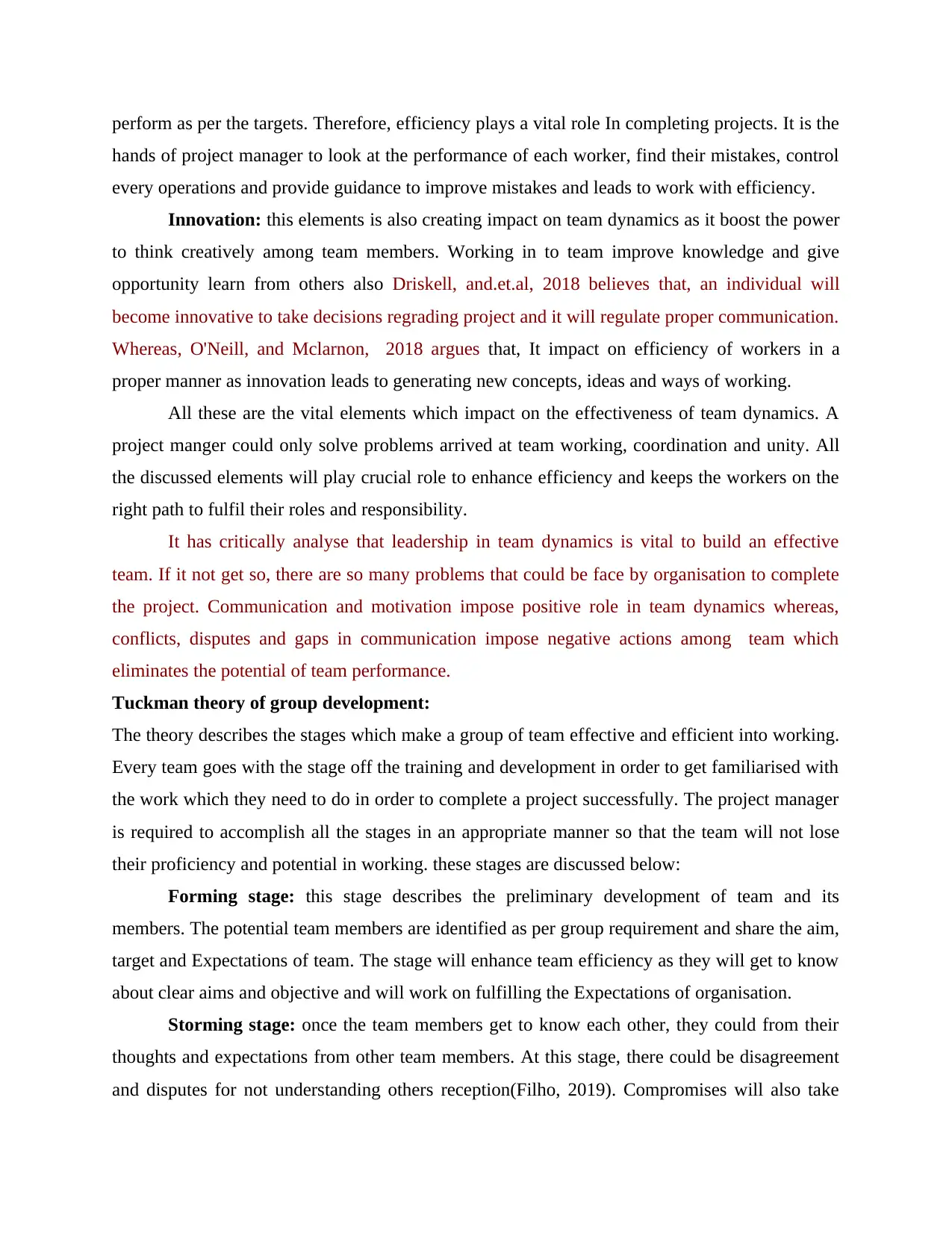
perform as per the targets. Therefore, efficiency plays a vital role In completing projects. It is the
hands of project manager to look at the performance of each worker, find their mistakes, control
every operations and provide guidance to improve mistakes and leads to work with efficiency.
Innovation: this elements is also creating impact on team dynamics as it boost the power
to think creatively among team members. Working in to team improve knowledge and give
opportunity learn from others also Driskell, and.et.al, 2018 believes that, an individual will
become innovative to take decisions regrading project and it will regulate proper communication.
Whereas, O'Neill, and Mclarnon, 2018 argues that, It impact on efficiency of workers in a
proper manner as innovation leads to generating new concepts, ideas and ways of working.
All these are the vital elements which impact on the effectiveness of team dynamics. A
project manger could only solve problems arrived at team working, coordination and unity. All
the discussed elements will play crucial role to enhance efficiency and keeps the workers on the
right path to fulfil their roles and responsibility.
It has critically analyse that leadership in team dynamics is vital to build an effective
team. If it not get so, there are so many problems that could be face by organisation to complete
the project. Communication and motivation impose positive role in team dynamics whereas,
conflicts, disputes and gaps in communication impose negative actions among team which
eliminates the potential of team performance.
Tuckman theory of group development:
The theory describes the stages which make a group of team effective and efficient into working.
Every team goes with the stage off the training and development in order to get familiarised with
the work which they need to do in order to complete a project successfully. The project manager
is required to accomplish all the stages in an appropriate manner so that the team will not lose
their proficiency and potential in working. these stages are discussed below:
Forming stage: this stage describes the preliminary development of team and its
members. The potential team members are identified as per group requirement and share the aim,
target and Expectations of team. The stage will enhance team efficiency as they will get to know
about clear aims and objective and will work on fulfilling the Expectations of organisation.
Storming stage: once the team members get to know each other, they could from their
thoughts and expectations from other team members. At this stage, there could be disagreement
and disputes for not understanding others reception(Filho, 2019). Compromises will also take
hands of project manager to look at the performance of each worker, find their mistakes, control
every operations and provide guidance to improve mistakes and leads to work with efficiency.
Innovation: this elements is also creating impact on team dynamics as it boost the power
to think creatively among team members. Working in to team improve knowledge and give
opportunity learn from others also Driskell, and.et.al, 2018 believes that, an individual will
become innovative to take decisions regrading project and it will regulate proper communication.
Whereas, O'Neill, and Mclarnon, 2018 argues that, It impact on efficiency of workers in a
proper manner as innovation leads to generating new concepts, ideas and ways of working.
All these are the vital elements which impact on the effectiveness of team dynamics. A
project manger could only solve problems arrived at team working, coordination and unity. All
the discussed elements will play crucial role to enhance efficiency and keeps the workers on the
right path to fulfil their roles and responsibility.
It has critically analyse that leadership in team dynamics is vital to build an effective
team. If it not get so, there are so many problems that could be face by organisation to complete
the project. Communication and motivation impose positive role in team dynamics whereas,
conflicts, disputes and gaps in communication impose negative actions among team which
eliminates the potential of team performance.
Tuckman theory of group development:
The theory describes the stages which make a group of team effective and efficient into working.
Every team goes with the stage off the training and development in order to get familiarised with
the work which they need to do in order to complete a project successfully. The project manager
is required to accomplish all the stages in an appropriate manner so that the team will not lose
their proficiency and potential in working. these stages are discussed below:
Forming stage: this stage describes the preliminary development of team and its
members. The potential team members are identified as per group requirement and share the aim,
target and Expectations of team. The stage will enhance team efficiency as they will get to know
about clear aims and objective and will work on fulfilling the Expectations of organisation.
Storming stage: once the team members get to know each other, they could from their
thoughts and expectations from other team members. At this stage, there could be disagreement
and disputes for not understanding others reception(Filho, 2019). Compromises will also take
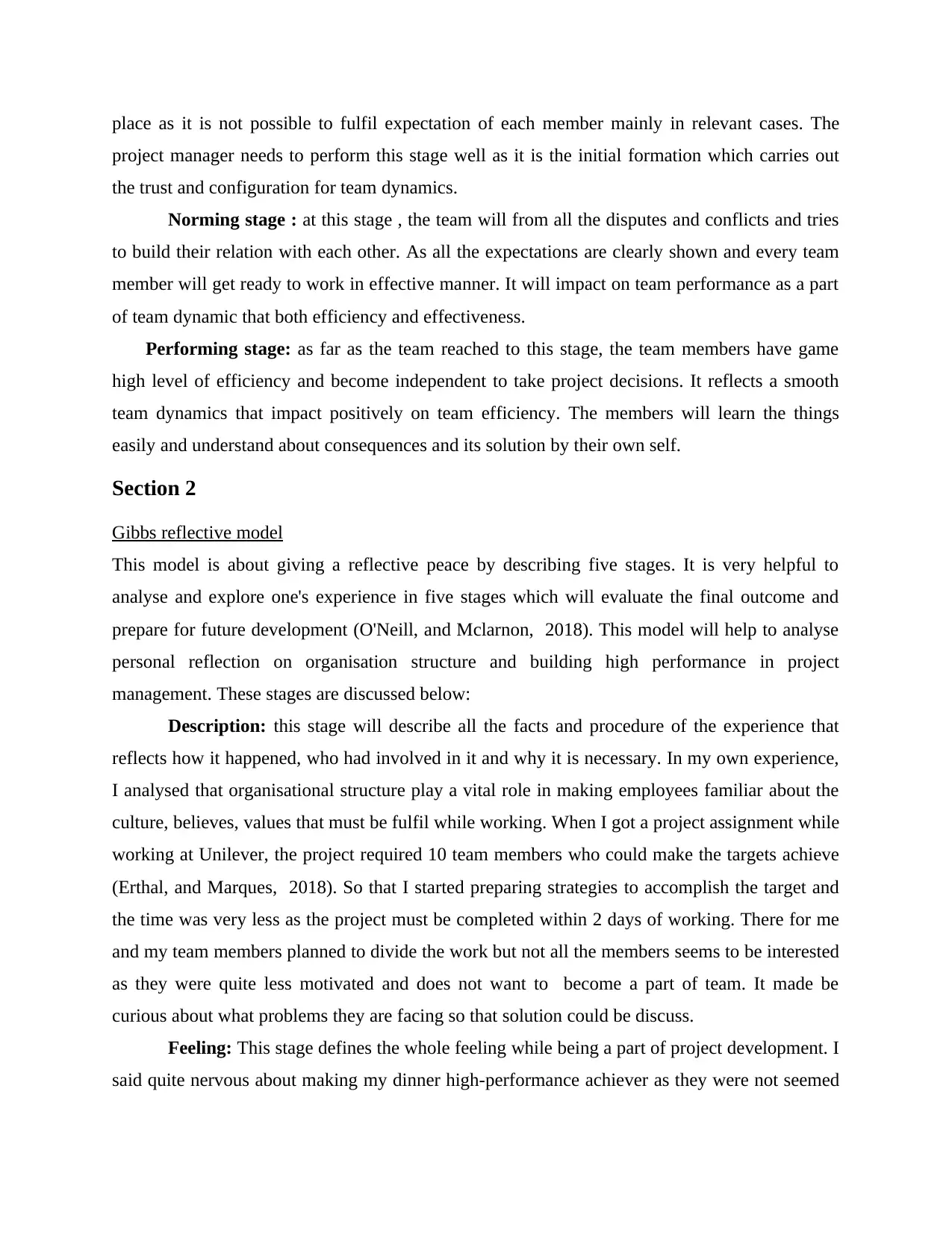
place as it is not possible to fulfil expectation of each member mainly in relevant cases. The
project manager needs to perform this stage well as it is the initial formation which carries out
the trust and configuration for team dynamics.
Norming stage : at this stage , the team will from all the disputes and conflicts and tries
to build their relation with each other. As all the expectations are clearly shown and every team
member will get ready to work in effective manner. It will impact on team performance as a part
of team dynamic that both efficiency and effectiveness.
Performing stage: as far as the team reached to this stage, the team members have game
high level of efficiency and become independent to take project decisions. It reflects a smooth
team dynamics that impact positively on team efficiency. The members will learn the things
easily and understand about consequences and its solution by their own self.
Section 2
Gibbs reflective model
This model is about giving a reflective peace by describing five stages. It is very helpful to
analyse and explore one's experience in five stages which will evaluate the final outcome and
prepare for future development (O'Neill, and Mclarnon, 2018). This model will help to analyse
personal reflection on organisation structure and building high performance in project
management. These stages are discussed below:
Description: this stage will describe all the facts and procedure of the experience that
reflects how it happened, who had involved in it and why it is necessary. In my own experience,
I analysed that organisational structure play a vital role in making employees familiar about the
culture, believes, values that must be fulfil while working. When I got a project assignment while
working at Unilever, the project required 10 team members who could make the targets achieve
(Erthal, and Marques, 2018). So that I started preparing strategies to accomplish the target and
the time was very less as the project must be completed within 2 days of working. There for me
and my team members planned to divide the work but not all the members seems to be interested
as they were quite less motivated and does not want to become a part of team. It made be
curious about what problems they are facing so that solution could be discuss.
Feeling: This stage defines the whole feeling while being a part of project development. I
said quite nervous about making my dinner high-performance achiever as they were not seemed
project manager needs to perform this stage well as it is the initial formation which carries out
the trust and configuration for team dynamics.
Norming stage : at this stage , the team will from all the disputes and conflicts and tries
to build their relation with each other. As all the expectations are clearly shown and every team
member will get ready to work in effective manner. It will impact on team performance as a part
of team dynamic that both efficiency and effectiveness.
Performing stage: as far as the team reached to this stage, the team members have game
high level of efficiency and become independent to take project decisions. It reflects a smooth
team dynamics that impact positively on team efficiency. The members will learn the things
easily and understand about consequences and its solution by their own self.
Section 2
Gibbs reflective model
This model is about giving a reflective peace by describing five stages. It is very helpful to
analyse and explore one's experience in five stages which will evaluate the final outcome and
prepare for future development (O'Neill, and Mclarnon, 2018). This model will help to analyse
personal reflection on organisation structure and building high performance in project
management. These stages are discussed below:
Description: this stage will describe all the facts and procedure of the experience that
reflects how it happened, who had involved in it and why it is necessary. In my own experience,
I analysed that organisational structure play a vital role in making employees familiar about the
culture, believes, values that must be fulfil while working. When I got a project assignment while
working at Unilever, the project required 10 team members who could make the targets achieve
(Erthal, and Marques, 2018). So that I started preparing strategies to accomplish the target and
the time was very less as the project must be completed within 2 days of working. There for me
and my team members planned to divide the work but not all the members seems to be interested
as they were quite less motivated and does not want to become a part of team. It made be
curious about what problems they are facing so that solution could be discuss.
Feeling: This stage defines the whole feeling while being a part of project development. I
said quite nervous about making my dinner high-performance achiever as they were not seemed
⊘ This is a preview!⊘
Do you want full access?
Subscribe today to unlock all pages.

Trusted by 1+ million students worldwide

to be interested. Organisational culture of Unilever has made my work simpler as they have a
proper line of communication and divisional structure which help me out to divide the work
among teams as per their specialisation (Middleton, 2017). I felt that understanding every
individual is necessary to know about what they want and what could motivate them for working
hard. The company has power task, role culture in which all the individuals have assigned the
power and roles and responsibilities as per their work efficiency. So I felt like make this an
opportunity for other team members to get higher position by increasing their effectiveness.
Evaluation: This stage evaluates about what happens right and wrong during the
experience. It has evaluated that organisation structure play a vital role to divide work and
responsibilities among individuals so that it avoids conflicts and discrimination. Also the
individuals will get family rides with cultural Expectations and beliefs of organisation. I make
my team understand about their roles and responsibilities due to which all members get clear
about their roles and we has started the project in an appropriate manner and made are possible
efforts to accomplish it before the deadline.
Analysis: I have analysed that by being a manager, it is my responsibility to make my
team aware about all the cultural norms and maintain a level of communication with Team. So
that there will be no path for doubt and confusion (Ogbeibu, and.et.al, 2018). This will enhance
team performance and what will get done through higher efficiency and perfection. I have also
analysed that leadership traits which I have play a vital role to guide and instruct every individual
and solve their problems while working.
Conclusion: It has concluded from my experience that organisational structure defines
the whole organisation and prepares the individuals for taking growth and higher performance
within company. Therefore, it teach the team as well as its leaders about working with the culture
and following believes will complete the target in an appropriate manner.
Action: I will work hard to be a better leader in future. As, I noticed some of my weakness
in problem solving during the project. I will focus on enhancing problem solving skills by getting
engaged in more of complex work and try to give my relevant opinion. Also I will make my
communication skills more improve eyes so that there will be no communication gap reflects
among team working.
proper line of communication and divisional structure which help me out to divide the work
among teams as per their specialisation (Middleton, 2017). I felt that understanding every
individual is necessary to know about what they want and what could motivate them for working
hard. The company has power task, role culture in which all the individuals have assigned the
power and roles and responsibilities as per their work efficiency. So I felt like make this an
opportunity for other team members to get higher position by increasing their effectiveness.
Evaluation: This stage evaluates about what happens right and wrong during the
experience. It has evaluated that organisation structure play a vital role to divide work and
responsibilities among individuals so that it avoids conflicts and discrimination. Also the
individuals will get family rides with cultural Expectations and beliefs of organisation. I make
my team understand about their roles and responsibilities due to which all members get clear
about their roles and we has started the project in an appropriate manner and made are possible
efforts to accomplish it before the deadline.
Analysis: I have analysed that by being a manager, it is my responsibility to make my
team aware about all the cultural norms and maintain a level of communication with Team. So
that there will be no path for doubt and confusion (Ogbeibu, and.et.al, 2018). This will enhance
team performance and what will get done through higher efficiency and perfection. I have also
analysed that leadership traits which I have play a vital role to guide and instruct every individual
and solve their problems while working.
Conclusion: It has concluded from my experience that organisational structure defines
the whole organisation and prepares the individuals for taking growth and higher performance
within company. Therefore, it teach the team as well as its leaders about working with the culture
and following believes will complete the target in an appropriate manner.
Action: I will work hard to be a better leader in future. As, I noticed some of my weakness
in problem solving during the project. I will focus on enhancing problem solving skills by getting
engaged in more of complex work and try to give my relevant opinion. Also I will make my
communication skills more improve eyes so that there will be no communication gap reflects
among team working.
Paraphrase This Document
Need a fresh take? Get an instant paraphrase of this document with our AI Paraphraser
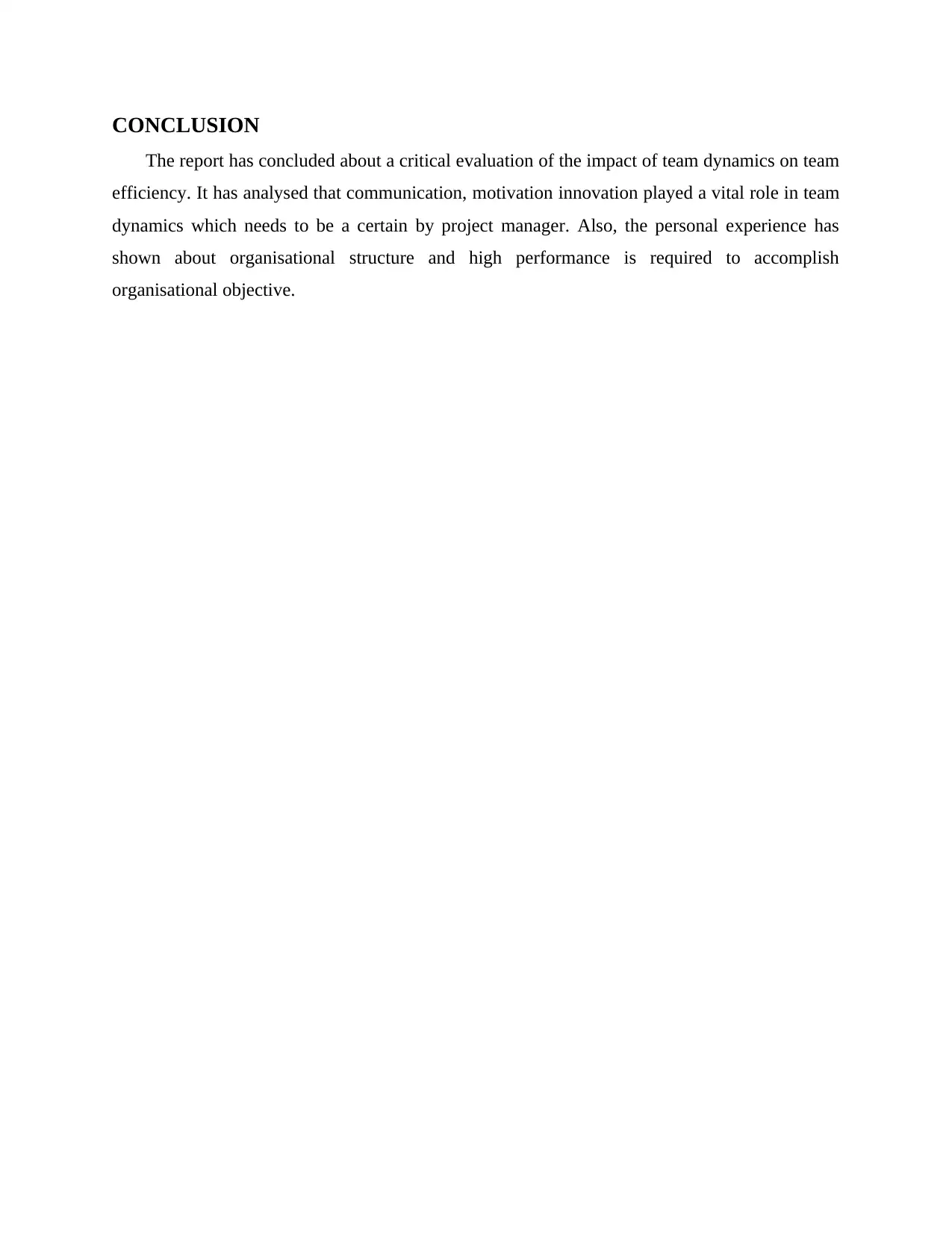
CONCLUSION
The report has concluded about a critical evaluation of the impact of team dynamics on team
efficiency. It has analysed that communication, motivation innovation played a vital role in team
dynamics which needs to be a certain by project manager. Also, the personal experience has
shown about organisational structure and high performance is required to accomplish
organisational objective.
The report has concluded about a critical evaluation of the impact of team dynamics on team
efficiency. It has analysed that communication, motivation innovation played a vital role in team
dynamics which needs to be a certain by project manager. Also, the personal experience has
shown about organisational structure and high performance is required to accomplish
organisational objective.
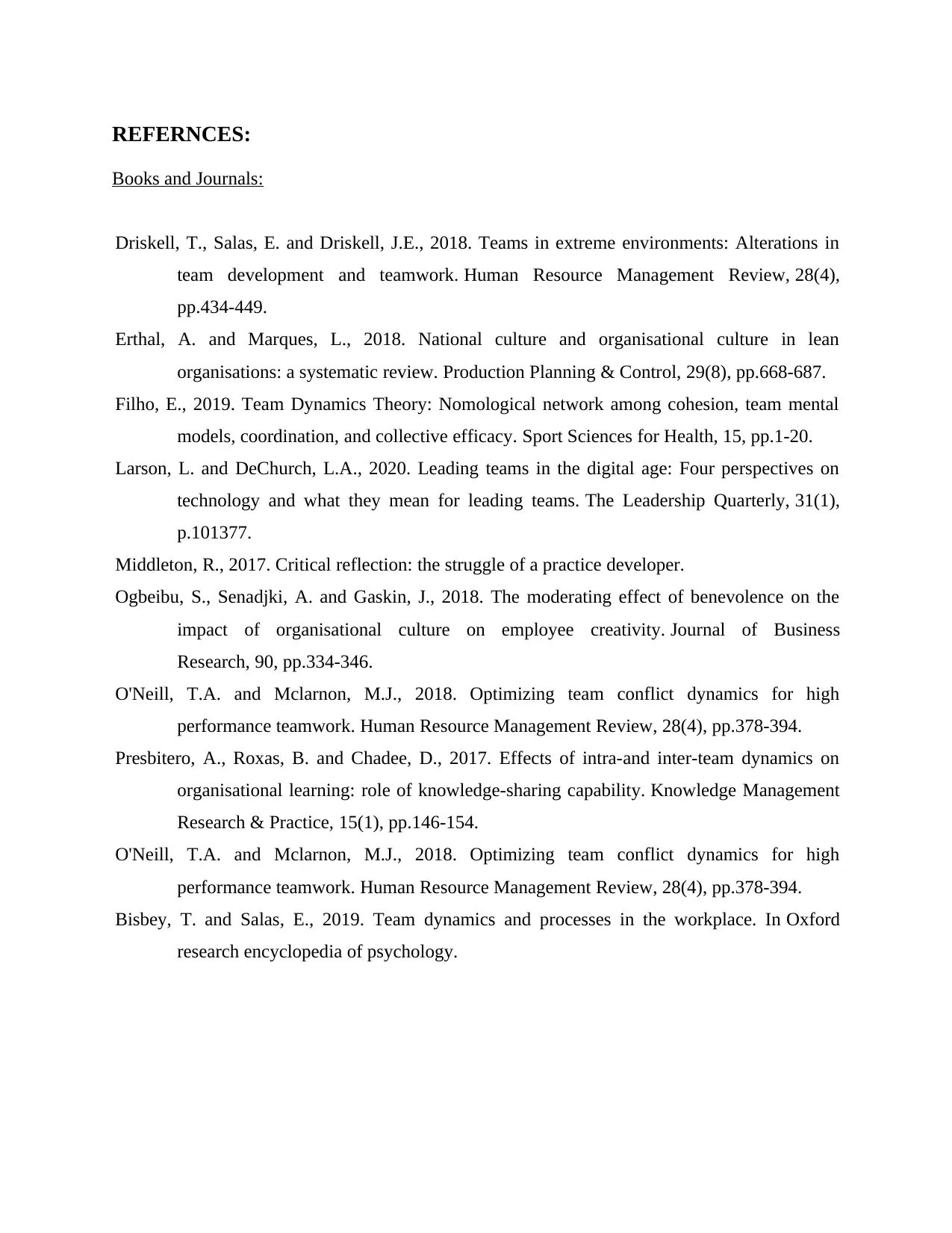
REFERNCES:
Books and Journals:
Driskell, T., Salas, E. and Driskell, J.E., 2018. Teams in extreme environments: Alterations in
team development and teamwork. Human Resource Management Review, 28(4),
pp.434-449.
Erthal, A. and Marques, L., 2018. National culture and organisational culture in lean
organisations: a systematic review. Production Planning & Control, 29(8), pp.668-687.
Filho, E., 2019. Team Dynamics Theory: Nomological network among cohesion, team mental
models, coordination, and collective efficacy. Sport Sciences for Health, 15, pp.1-20.
Larson, L. and DeChurch, L.A., 2020. Leading teams in the digital age: Four perspectives on
technology and what they mean for leading teams. The Leadership Quarterly, 31(1),
p.101377.
Middleton, R., 2017. Critical reflection: the struggle of a practice developer.
Ogbeibu, S., Senadjki, A. and Gaskin, J., 2018. The moderating effect of benevolence on the
impact of organisational culture on employee creativity. Journal of Business
Research, 90, pp.334-346.
O'Neill, T.A. and Mclarnon, M.J., 2018. Optimizing team conflict dynamics for high
performance teamwork. Human Resource Management Review, 28(4), pp.378-394.
Presbitero, A., Roxas, B. and Chadee, D., 2017. Effects of intra-and inter-team dynamics on
organisational learning: role of knowledge-sharing capability. Knowledge Management
Research & Practice, 15(1), pp.146-154.
O'Neill, T.A. and Mclarnon, M.J., 2018. Optimizing team conflict dynamics for high
performance teamwork. Human Resource Management Review, 28(4), pp.378-394.
Bisbey, T. and Salas, E., 2019. Team dynamics and processes in the workplace. In Oxford
research encyclopedia of psychology.
Books and Journals:
Driskell, T., Salas, E. and Driskell, J.E., 2018. Teams in extreme environments: Alterations in
team development and teamwork. Human Resource Management Review, 28(4),
pp.434-449.
Erthal, A. and Marques, L., 2018. National culture and organisational culture in lean
organisations: a systematic review. Production Planning & Control, 29(8), pp.668-687.
Filho, E., 2019. Team Dynamics Theory: Nomological network among cohesion, team mental
models, coordination, and collective efficacy. Sport Sciences for Health, 15, pp.1-20.
Larson, L. and DeChurch, L.A., 2020. Leading teams in the digital age: Four perspectives on
technology and what they mean for leading teams. The Leadership Quarterly, 31(1),
p.101377.
Middleton, R., 2017. Critical reflection: the struggle of a practice developer.
Ogbeibu, S., Senadjki, A. and Gaskin, J., 2018. The moderating effect of benevolence on the
impact of organisational culture on employee creativity. Journal of Business
Research, 90, pp.334-346.
O'Neill, T.A. and Mclarnon, M.J., 2018. Optimizing team conflict dynamics for high
performance teamwork. Human Resource Management Review, 28(4), pp.378-394.
Presbitero, A., Roxas, B. and Chadee, D., 2017. Effects of intra-and inter-team dynamics on
organisational learning: role of knowledge-sharing capability. Knowledge Management
Research & Practice, 15(1), pp.146-154.
O'Neill, T.A. and Mclarnon, M.J., 2018. Optimizing team conflict dynamics for high
performance teamwork. Human Resource Management Review, 28(4), pp.378-394.
Bisbey, T. and Salas, E., 2019. Team dynamics and processes in the workplace. In Oxford
research encyclopedia of psychology.
⊘ This is a preview!⊘
Do you want full access?
Subscribe today to unlock all pages.

Trusted by 1+ million students worldwide
1 out of 9
Related Documents
Your All-in-One AI-Powered Toolkit for Academic Success.
+13062052269
info@desklib.com
Available 24*7 on WhatsApp / Email
![[object Object]](/_next/static/media/star-bottom.7253800d.svg)
Unlock your academic potential
Copyright © 2020–2025 A2Z Services. All Rights Reserved. Developed and managed by ZUCOL.





